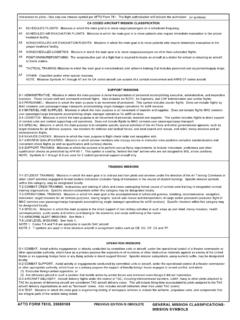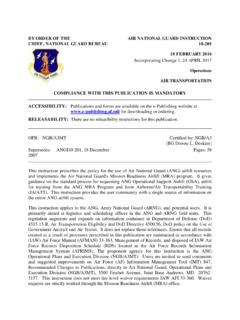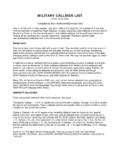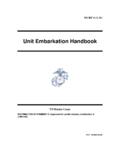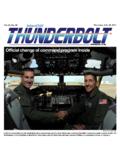Transcription of Maintenance Metrics Handbook U.S. Air Force - …
1 2. Acknowledgments The Metrics Handbook for Maintenance Leaders was produced by the Air Force Logistics Management Agency for use in the Air Force Maintenance community. The project was commissioned by the Director of Maintenance , Deputy Chief of Staff, Installations and Logistics, United States Air Force . Specific questions concerning the content should be addressed to the Directorate of Maintenance . Grateful acknowledgment is extended to the many action officers at the Air Staff and major commands who contributed to the writing and production effort. The Editors, Air Force Journal of Logistics James C. Rainey, Editor-in-Chief Senior Master Sergeant Robert McGonagle, Associate Editor Beth F. Scott, Editor Lieutenant Colonel Gail Waller, Contributing Editor Graphics and Layout James C.
2 Rainey Beth F. Scott Senior Master Sergeant Robert McGonagle Lieutenant Colonel Mark R. McConnell Chief Master Sergeant John G. Drew 20 December 2001. Air Force Logistics Management Agency 501 Ward Street Maxwell AFB, Gunter Annex, Alabama 36114-3236. DSN: 596-4087/4088. Commercial: (334) 416-4087/4088. FAX: (334) 416-5890. Foreword A. ircraft Maintenance Metrics are important. Don't let anyone tell you differently! They are critical tools to be used by Maintenance managers to gauge an organization's effectiveness and efficiency. In fact, they are roadmaps that let you determine where you've been, where you're going, and how (or if). you're going to get there. Use of Metrics allows you to flick off your organizational autopilot and actually guide your unit.
3 But they must be used correctly to be effective. Chasing Metrics for Metrics ' sake is a bad thing and really proves nothing. A good Maintenance manager will not strive to improve a metric but will use them to improve the performance of the organization. The intent of this Handbook is to help reacquaint or introduce managers at all levels to these necessary tools of trade. I encourage each of you to read this Handbook and keep it close at hand for future reference. Discuss the importance of Metrics with others in the Maintenance community. Today's Air Force has the best people, parts, and equipment in the world. My hope is that this Handbook will help you capitalize on these strengths. As a Maintenance leader, your task is to provide good iron to the operators when needed.
4 It is your responsibility. Understanding Metrics and their use in effectively and efficiently managing aircraft Maintenance is key to your ability to uphold that responsibility. Good luck. Terry L. Gabreski, Brigadier General, USAF. Director of Logistics Air Force Materiel Command 3 Air Force Maintenance Metrics 4. Special Interest Understanding Metrics Table of Contents .. 13. Foreword Key Metrics Table .. 3.. 25-26. Introduction Maintenance Metrics .. 5. Formula Index .. 30 Chapter 1.. 7. Maintenance Metrics Formulas and Chapter 2. Discussion .. 31-50.. 23. CHAPTER Chapter 3. CONTENTS .. 29. Maintenance Metrics Chapter 4. Basics .. 57.. 7. Chapter 5. Assessing the .. 70. Health of the Fleet .. 23. The Metrics .
5 29. Helpful Hints for Data Investigation .. 57. References and Supporting Information .. 70. Introduction The purpose of this Handbook is to provide Maintenance leaders at both the wing and major command (MAJCOM). level with a comprehensive guide to Metrics associated with Maintenance management. 5. 6 Introduction T. his Handbook is an encyclopedia of Metrics and includes an overview to Metrics , a brief description of things to consider when analyzing fleet statistics, an explanation of data that can be used to perform analysis, MAJCOM formulas a detailed description of each metric, a formula to calculate mayNote: deviate MAJCOM. the metric, and an explanation of the metric's importance slightly. For exact formulas may deviate and relationship to other Metrics .
6 The Handbook also slightly. formulas, For exact check identifies which Metrics are leading indicators (predictive) withformulas, check with the MAJCOM. and which are lagging indicators (historical). It is also a logistics analysis logistics the MAJCOM. analysis division. division. guide for data investigation. However, a word of caution is in order at this point. Overemphasis of a particular metric while ignoring the root cause of a problem may well lead to an improvement in the metric but worsening of the problem. Metrics are indicators and, as such, should be viewed in aggregate. The relationship between two Metrics may be so intertwined as to make it impossible for the Maintenance manager to separate the cause from the effect.
7 Generally, Metrics should be used to identify trends and not as pass or fail indicators. Individually, they are snapshots in time, and even the best organizations will occasionally dip below standards. Good Metrics analysis, however, will focus the Maintenance manager's attention on those areas where improvements can be realized. MAJCOM formulas may deviate slightly. For exact formulas, check with the MAJCOM logistics analysis division. Chapter 1. Maintenance Metrics Basics Special Interest Scheduling .. 8. Work Force Management .. 9. Sortie Generation .. 11. Maintenance Performance .. 11. Equipment/Mission Analysis .. 13. Fleet Availability .. 14. Program Execution .. 17. Maintenance Training .. 19. CHAPTER.
8 CONTENTS. Foundations for Metrics .. 8. Understanding Metrics .. 13. 7. 8 Chapter 1. Maintenance Metrics Basics M. etrics are nothing more than a barometer for pain. As leaders, our responsibility is to know where the pain is in order to alleviate it. Understanding the unit's Maintenance Metrics is only the first part of The flying schedule learning to manage the pain. Metrics are not just charts and sets the pace for numbers to be looked at. They are tools for fixing problems. the entire wing. It If the tool does not generate questions, it is a waste of time. must be built on If a lot of time is spent looking at Metrics that do not address sound principles daily problems affecting the unit, their value is that are clearly questionable.
9 When there is no applicable metric for driving articulated and unit performance, build one. Watch for filtering of the vigorously Metrics that show the pain they are the ones with the defended by wing greatest value. If a metric rarely meets its prescribed leadership. The standard, the standard is probably not realistic for one of flying schedule is two reasons it was arbitrarily set too high, or significant an important issues need resolution. Either way, investigation into the document for circumstances is warranted. consumption of Air Force resources, and the sortie is the focal point of consumption. Foundations for Metrics Scheduling. The flying schedule sets the pace for the entire wing. It must be built on sound principles that are clearly articulated and vigorously defended by wing leadership.
10 The flying schedule is an important document for consumption of Air Force resources, and the sortie is the focal point of consumption. We focus on the sortie and all Chapter 1. Maintenance Metrics Basics the events required for it to succeed. We establish a schedule to attempt a smooth flow of resource use that includes people, aircraft, and consumables. Without a schedule, all the moving parts certainly would not come The schedule together efficiently. becomes a contract Work Force Management. Key to any Maintenance that identifies activity is the availability of personnel. A schedule allows requirements the work Force needed to support the required task to be (number of sorties identified, manipulated, and managed.)
